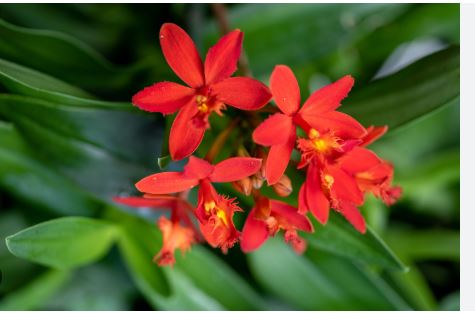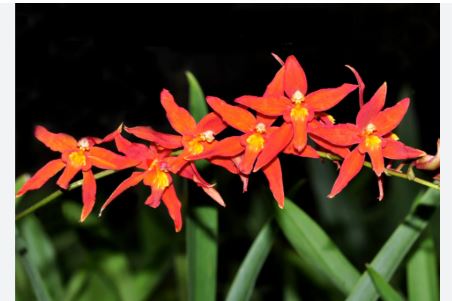
Red orchids, with their fiery hues, symbolize passion and vitality, captivating growers and enthusiasts. Varieties like Phragmipedium besseae and Vanda hybrids boast vivid red blooms, often with contrasting lips or veining. Their striking colors make them ideal for bold displays or gifts.
These orchids thrive in diverse conditions, from the wet, terrestrial habitats of Phragmipedium to the airy, epiphytic settings of Renanthera. Most prefer bright, indirect light, high humidity, and well-draining media like bark. Care varies, with some needing cool nights to bloom.
Red orchids exhibit stunning diversity in form. Mokara’s dense, star-like clusters contrast with Sophronitis’ tiny, scarlet blooms. Unique traits, like Bulbophyllum’s musky scent or Catasetum’s pollen-ejecting flowers, add intrigue for collectors.
Many red orchids, like Cambria and Miltonia, offer sweet or spicy fragrances, enhancing their allure. Their blooms, lasting weeks to months, attract pollinators and admirers alike. Hybrids ensure vibrant reds are accessible to all growers.
Culturally, red orchids evoke energy and celebration, gracing events from weddings to festivals. Widely available through nurseries, their vibrant beauty elevates gardens and interiors, embodying nature’s bold artistry.

Types of Red Orchids
Phragmipedium besseae
A striking lady slipper orchid native to Peru and Ecuador, Phragmipedium besseae is renowned for its vivid red flowers, a rarity among slipper orchids. It grows terrestrially or lithophytically near streams in humid environments.
Identifying Characteristics:
- Bright red, pouch-like lip with glossy, oval-shaped petals.
- Flowers are 2–3 inches wide, borne singly or sequentially on a spike.
- Narrow, grass-like leaves form a fan-like base.
- Prefers constant moisture, mimicking its “wet feet” natural habitat.
- Blooms last 4–6 weeks, often in spring or summer.
Mokara (Ruby Mokara)
A manmade hybrid from Singapore, created by crossing Arachnis and Vanda, Mokara orchids are epiphytic and popular as cut flowers. The Ruby Mokara cultivar is prized for its stunning red blooms.
Identifying Characteristics:
- Vibrant red petals and sepals with subtle dark red spotting.
- Small, dainty yellow lip with a windmill-like flower pattern.
- Flowers (1–2 inches) cluster densely on upright racemes, 6–10 per stem.
- Fleshy, robust stalk with alternating, lanceolate leaves.
- Blooms last 3–5 weeks, thriving in high humidity and bright light.
Cattleya (Rlc. Love Passion ‘Orange Bird’)
This Rhyncholaeliocattleya hybrid (Rlc. William Farrell × Ctt. Trick or Treat) is known for its bold, orange-red blooms, often classified as red in orchid collections. It’s a showy epiphyte with a compact growth habit.
Identifying Characteristics:
- Bright orange-red flowers, 2–3 inches wide, with a clustered spray.
- Ruffled petals and a prominent, slightly darker lip.
- Slender pseudobulbs with 1–2 thick, waxy leaves.
- Fragrant blooms last 3–4 weeks, typically in spring or fall.
- Requires bright light and moderate humidity.
Dendrobium (Den. ‘Peng Seng’)
A hybrid of Dendrobium cruentum and Dendrobium tobaense, this Latouria-type Dendrobium is celebrated for its waxy, long-lasting red-throated flowers. It’s a hardy epiphyte from Southeast Asia.
Identifying Characteristics:
- Lime-green petals with a deep red throat, creating a striking contrast.
- Waxy flowers, 1–2 inches, on arching spikes.
- Hard, cane-like pseudobulbs with narrow, alternating leaves.
- Blooms last up to 6 weeks, often in spring or summer.
- Prefers bright, indirect light and occasional drying out.
Vanda (Red Hybrids)
Vanda orchids, native to Southeast Asia, are known for their vibrant, large flowers. Red hybrids, such as those derived from Vanda sanderiana, display rich red or reddish-purple tones.
Identifying Characteristics:
- Large, circular red flowers, 3–4 inches wide, with a full, rounded shape.
- Petals may have subtle veining or spotting in darker red.
- Thick, leathery strap leaves in a fan-like arrangement.
- Aerial roots and a preference for hanging baskets with no media.
- Blooms last 4–6 weeks, 2–3 times a year in warm, humid conditions.
Cambria (Vuylstekeara Cambria ‘Plush’)
A hybrid of Odontoglossum, Miltonia, and Cochlioda, Cambria ‘Plush’ is a popular orchid with vibrant red and white flowers. It’s prized for its extravagant blooms and ease of care.
Identifying Characteristics:
- Large, red flowers (3–4 inches) with white accents and yellow-marked lips.
- Up to 12 flowers per spike, blooming in winter or spring.
- Slender pseudobulbs with long, narrow leaves.
- Fragrant blooms last 4–6 weeks.
- Prefers intermediate temperatures (65–75°F) and shaded light.
Phalaenopsis (Red Hybrids)
Moth orchids like Phalaenopsis red hybrids (e.g., Phalaenopsis Sogo Vivien or Phalaenopsis Red Star) are beginner-friendly with vibrant red blooms, often bred for intense color.
Identifying Characteristics:
- Deep red or reddish-orange flowers, 2–3 inches, on arching spikes.
- Broad, flat petals with a small, contrasting lip.
- Wide, leathery leaves in two rows from a central stem.
- Blooms last 2–3 months, often reblooming throughout the year.
- Thrives in low to medium light and high humidity.
Oncidium (Red Hybrids, e.g., Oncidium Sharry Baby ‘Red’)
Known as dancing lady orchids, Oncidium hybrids like Sharry Baby ‘Red’ are famous for their sprays of small, vibrant flowers and chocolate-like scent, though red varieties lean more toward reddish-brown.
Identifying Characteristics:
- Small, reddish-brown to red flowers, 1–2 inches, in branching sprays.
- Petals resemble a dancing figure with a prominent lip.
- Thin pseudobulbs with grassy leaves, often growing out of pots.
- Blooms last 3–5 weeks, typically in fall or winter.
- Prefers even moisture and bright, indirect light.
Maxillaria (Red Varieties)
Maxillaria orchids, like Maxillaria tenuifolia, include red varieties often called flame orchids. These epiphytes are compact and known for their coconut-like fragrance.
Identifying Characteristics:
- Fiery red flowers, 1–2 inches, with yellow-tipped petals.
- Triangular or star-shaped blooms, often single or in small clusters.
- Small, oval pseudobulbs with one or two narrow leaves.
- Blooms in early spring, lasting 3–4 weeks.
- Loves bright light and frequent watering.
Catasetum (Red Varieties)
Catasetum orchids, native to Central and South America, are deciduous and produce distinct male or female flowers. Red varieties, like those derived from Catasetum pileatum, are waxy and dramatic.
Identifying Characteristics:
- Waxy, red or reddish-brown male flowers, 2–3 inches, with a pollen-ejecting trigger.
- Arching inflorescences from tall pseudobulbs with fan-like leaves.
- Leaves drop during winter dormancy.
- Blooms in late summer or early fall, lasting 3–5 weeks.
- Requires a dry rest period post-blooming.
Brassia (Red Hybrids)
Known as spider orchids, Brassia hybrids with red coloration, such as those crossed with Brassia verrucosa, feature long, spidery petals and vibrant hues.
Identifying Characteristics:
- Bright red or orange-red flowers, 3–5 inches, with elongated, narrow petals.
- Petals may have brown spotting near the base.
- Flowers on loose, arching spikes, often fragrant at night.
- Oval pseudobulbs with long, narrow leaves.
- Blooms last 3–4 weeks, preferring high humidity.
Cymbidium (Cymbidium ‘Magic Chocolate’)
While typically known for green or pink blooms, Cymbidium hybrids like ‘Magic Chocolate’ produce striking brownish-red flowers. These boat orchids are robust and popular for outdoor growth.
Identifying Characteristics:
- Brownish-red petals with a white and brown speckled throat, 2–3 inches.
- Multiple flowers (10–20) on tall spikes, lasting 8–12 weeks.
- Small pseudobulbs with long, grassy leaves.
- Blooms in late winter to early spring, often fragrant.
- Needs cool nights (below 60°F) to initiate flowering.
Epidendrum (Red Hybrids, e.g., Epidendrum Fire Star)
Epidendrum orchids, often called reed-stem orchids, include red hybrids like Epidendrum Fire Star, known for their vibrant, clustered blooms. These epiphytes are hardy and prolific bloomers.
Identifying Characteristics:
- Small, bright red flowers, 1–2 inches, in dense clusters at stem tips.
- Star-shaped petals with a small, yellow-marked lip.
- Tall, reed-like stems with alternating, narrow leaves.
- Blooms last 4–6 weeks, often continuously in warm climates.
- Tolerates bright light and moderate humidity.
Paphiopedilum (Red Hybrids, e.g., Paphiopedilum Maudiae ‘Red’)
Paphiopedilum, or lady slipper orchids, include red hybrids derived from species like Paphiopedilum callosum. The ‘Red’ Maudiae type features rich, reddish-burgundy flowers.
Identifying Characteristics:
- Single, waxy, reddish-burgundy flower with a pouch-like lip, 3–4 inches.
- Petals often have white or green veining; lip is deep red.
- Mottled, green leaves in a fan-like rosette.
- Blooms last 6–8 weeks, typically in fall or winter.
- Prefers low light and high humidity.
Miltonia (Red Hybrids, e.g., Miltonia Sunset)
Miltonia orchids, also called pansy orchids, have red hybrids like Miltonia Sunset with vibrant, open-faced blooms. These epiphytes are prized for their vivid colors and fragrance.
Identifying Characteristics:
- Large, reddish-orange to red flowers, 2–3 inches, resembling pansies.
- Lip often has yellow or white markings for contrast.
- Flowers on short spikes, 3–5 per stem.
- Soft, light green leaves from small pseudobulbs.
- Blooms last 4–6 weeks with a sweet, floral scent.
Renanthera
Renanthera orchids, like Renanthera imschootiana, are tropical epiphytes native to Southeast Asia, known for their fiery red blooms and sprawling growth. They’re popular in warm climates.
Identifying Characteristics:
- Small, bright red flowers, 1–2 inches, in dense, branching panicles.
- Petals are narrow and slightly twisted, with a small lip.
- Long, strap-like leaves in a fan-like arrangement.
- Blooms last 3–5 weeks, typically in summer.
- Requires high humidity, bright light, and good air circulation.
Sophronitis (Sophronitis coccinea)
Sophronitis coccinea, a miniature orchid from Brazil, is known for its brilliant scarlet-red flowers. Often used in hybridization, it’s a compact epiphyte with vibrant blooms.
Identifying Characteristics:
- Tiny, vivid red flowers, 1–2 inches, usually one per stem.
- Rounded petals with a small, matching red lip.
- Small, oval leaves on short pseudobulbs.
- Blooms in late winter to spring, lasting 3–4 weeks.
- Prefers cool temperatures and moderate light.
Bulbophyllum (Red Varieties, e.g., Bulbophyllum lobbii)
Bulbophyllum orchids are diverse, with red varieties like Bulbophyllum lobbii featuring unusual, often fragrant flowers. These epiphytes are quirky and favored by collectors.
Identifying Characteristics:
- Single, reddish-brown to red flowers, 2–3 inches, with a hinged lip.
- Petals are waxy, often with a mottled or spotted appearance.
- Small, round pseudobulbs with a single, thick leaf.
- Blooms last 2–4 weeks, often with a strong, musky scent.
- Thrives in warm, humid conditions with shaded light.
Notes:
- Care Considerations: Red orchids vary in care needs. Phragmipedium besseae loves wet conditions, while Catasetum requires a dry dormancy. Most prefer bright, indirect light, high humidity (50–70%), and well-draining media like bark or sphagnum moss.
- Availability: Hybrids like Mokara, Cambria, and Phalaenopsis red varieties are widely available at nurseries or online. Species like Phragmipedium besseae may require specialty growers.
- Cultural Significance: Red orchids symbolize passion, strength, and vitality, making them popular for bold displays or gifts.